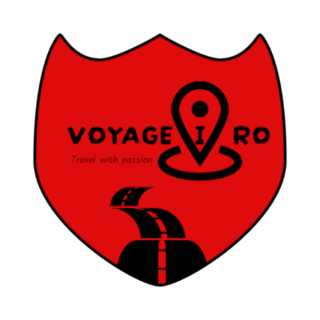GHENT
A proud medieval city
What is in this post?
Location Information

Country
Language
Currency
Distance to capital
Inhabitants nickname
Timezone
Belgium
Dutch
Euro [€]
56 km
Stroppendragers
Winter : UTC + 1
Summer : UTC + 2
Introduction to Ghent as a proud medieval city
The capital of East-Flanders in Belgium is Ghent. A large city that already was an important place to be in the Middle Ages. Famous in the city are the 3 towers as well as the many medieval buildings. These buildings remember us that Ghent was one of the largest cities in Europe in the Middle Ages. Read more to travel through Ghent as a proud medieval city.
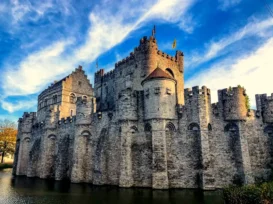
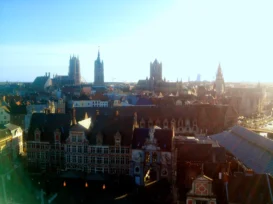
1400 Years of history
The history of Ghent starts already from the 7th century. Ghent endured already a lot of important historical facts. Because in history, Flanders was ruled by a lot of different cultures. But Ghent was strong, survived a lot of them and stayed in tact. So these days, you still can discover around of 1400 years of history together on a compact area.
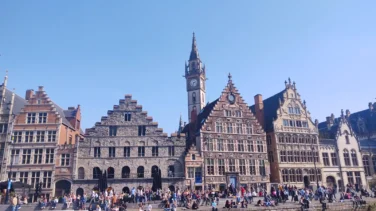
The wealth and grandeur of a proud medieval city
Ghent is a city at the Leie river and had the highest glory moments in the Middle Ages. In that period was Ghent one of the largest cities in Europe. At a specific moment was Ghent more important as London and it only had to tolerate Paris above them. The wealth and grandeur came from the trade in wool, iron, fish and especially cloth and grain. In the period of industrialisation, at the end of the 18th century, Ghent was the first city on the mainland of Europe to industrialise, especially in the linen and cotton industry. This was a famous product in the lower countries.
Quirky and proud
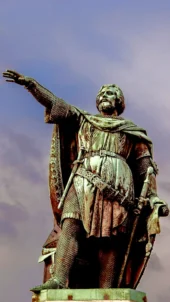
Jacob van Artevelde
The people of Ghent also are known as quirky and proud. In a historical fact like the 100 years war, between France and England, the people of Ghent sided by the English and against the French. The trade of cloth and wool was very important for Ghent. France issued a ban of trading with England. But in Ghent, they went against these orders. Key figure in this pact with England was Jacob van Artevelde. These days, Ghent is still called "Arteveldestad", the city of Artevelde.
Noose bearers
Also around 200 years later, there was a dispute with Emperor Charles V, who was born in Ghent. Charles needed money for his army and he raised the taxes in the cities of his empire. But Ghent doesn't wanted to follow this rule, because it would kill them economically. So, Charles came to Ghent to make an end at the revolution in his city of birth. He let kill 25 leaders. While many others had to walk through the city with a noose around the neck to do penance. This is why people of Ghent are called "Noose bearers", or in Duch "Stroppendragers". People of Ghent are very proud on their nickname and now they wear the noose with a great pride as a symbol of a proud resistance against any form of tyranny and misplaced authority. Every year on the 10-days Ghent Festivals, you will see a lot of people wearing a noose in the colours of the flag of Ghent.
Popular must do & see
A lot of guides and travel sites tell you about the popular spots and things to do in a city. According Voyageiro, these are the 5 most popular things you must do and see in Ghent.
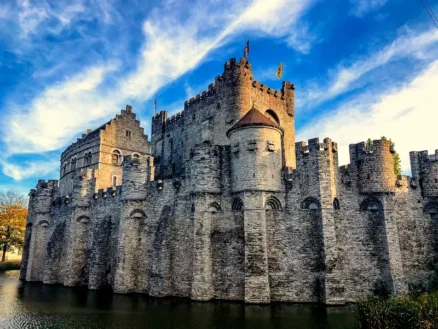
The house of the Counts of Flanders
Central in the city stands a medieval historic fortified castle, called Gravensteen. This fortress dates from the 12th century and was the home of the Counts of Flanders. The counts stayed here till the 14th century to rule over the Flanders of that time. Afterwards the highest court settled here, as well as a prison, a coin company and even finally a cotton company.
An important spot
In the Middle Ages, the Gravensteen was maybe the most important building in Flanders. Now it stands alone surrounded by water and the Sint-Veerleplein. But in the past there were a lot of houses and shops built against the Gravensteen, so that the building was a more hidden spot.
Visit the museum
Now it is a museum and is possible to visit. When you are in Ghent, the Gravensteen is a must do to bring you back in time to the period of the Middle Ages in Ghent and Flanders.
3 Towers mark the skyline of Ghent
When you talk about Ghent, you can't pass by seeing the 3 towers of Ghent. The people of Ghent are very proud on them. They are the tower of the Saint Nicholas Church, the Belfry and the Saint Bavo's Cathedral.
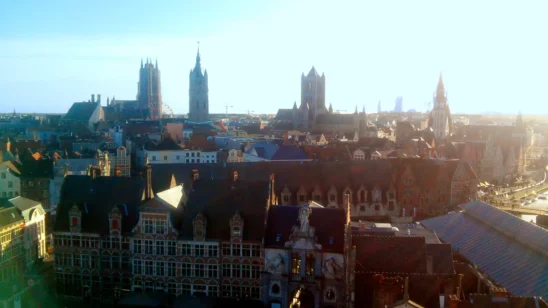
Saint Nicholas Church
Aside the Korenmarkt, central in the city of Ghent, stands the Sint-Niklaaskerk, Saint Nicholas Church. This church is built up in a Gothic style. Very typical for this church is that the tower doesn't stand at the main entrance of the church. But it stands central at the crossing of the church, the place where the main aisle and side aisles (transepts) cross together. Or in other words, above the place where the altar stands and the cross of Jesus Christ hangs. In this way, the tower acts as a lantern to bring natural light in the church.
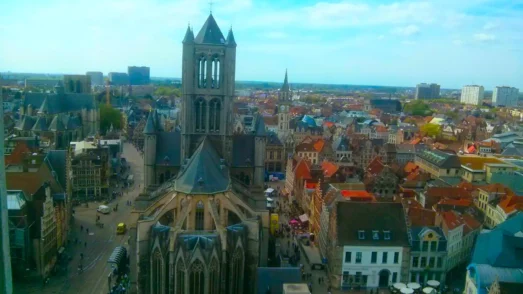
The Belfry
In the middle stands the Belfry of Ghent. This building is classified as UNESCO World Heritage. This is the highest tower of the 3 and stands as a symbol for the prosperity and independency of the city.
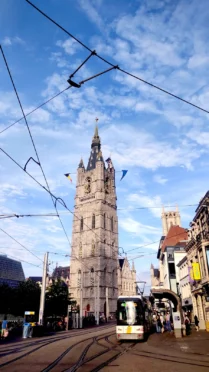
Protect the city
Another important function of a belfry was to protect the city. In the Middle Ages, the city privileges were kept in the belfry. The dragon on the top of the belfry stands as a symbol to look over the city of Ghent and protect the people as well as protecting the stored documents in the belfry. Till half of the 15th century, the tower of the Saint Nicholas church was used as a watchtower by the city guards. Afterwards, the city guards took place on the belfry to inform the people about the direction of the disaster in the city.
Go to the top
The belfry of Ghent is an absolutely must visit building on your city trip. Take the stairs upwards and enjoy the wonderful views over the city of Ghent.
Saint Bavo's Cathedral
The last tower of the 3, is the tower of the Saint Bavo's Cathedral. This cathedral dates out of the 15th and 16th century and has a lot of important history. Saint Bavo is the oldest parochial church in Ghent and is full of art to discover. Here you can see the world famous Lam Gods, the Lamb of God, painted by the brothers Van Eyck.
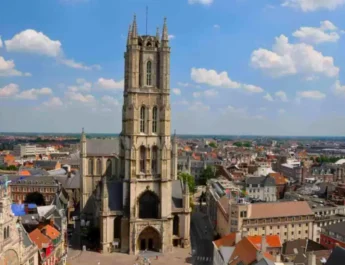
At the place of a church
Like in many cities in Europe, this cathedral was built on the place of an older church. Firstly, here stood already a church in the 10th century. But this cathedral was built in the 15th century to enlarge a church in a Romance style out of the 12th century. The Romance central nave is still possible to see in the crypt of this cathedral.
Spanish Catholic Christians after the Iconoclasm
According my personal experiences, a lot of cathedrals in Europe are wonderful to see outside, but have a relatively sober look and feel inside. But in the Saint Bavo's Cathedral stands a lot of attractive statues and decorations. This comes through the iconoclasm in the lower countries of Europe in the 16th century, de Beeldenstorm. A lot of statues of the Catholic Church were destroyed by Protestants. At that time, Flanders was under Spanish rule. So, the Spanish Catholic Christians drove the Protestants to the north. Afterwards, they brought a lot of statues to the churches of Flanders to attract the people again to the Catholic Church.
To feel the real medieval history of Ghent, you have to be at the Graslei and Korenlei aside the river Leie. Already in the Middle Ages, this was the one of the most important ports for traders in Europe. Now it is the home of many restaurants and bars. A lot of students and tourists find a seat aside the river with their friends and a drink. In the summer, during the 10 days of the Gentse Feesten, this is a place to be to enjoy one of the best vibes of the city festival.
Traders in the Middle Ages
Traders arrived here with their merchandise. Important products where cloth, wool, grain, fish, iron and wood. Ghent was an important hub in the trade of grain and cloth. This made Ghent a very rich city. Most of the buildings at this location were Guild houses. Guilds were organizations of traders with the same profession. One of the most impressive and best preserved guild houses is of the free skippers, Gilde der Vrije Schippers.
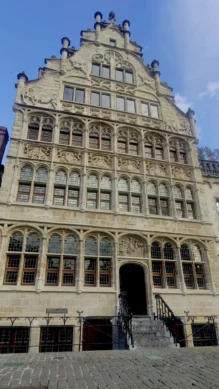
A little bit out of the city centre, you find Gent Zuid. This is the southern side of the city. Because it is not part of the historical heart of the city, it is more a hidden neighbourhood in the city for a lot of people. But, you reach Gent Zuid in around 10 minutes walking from the belfry. This is the home of a lot impressive spots in Ghent.
Find a good restaurant
First of all, when you walk from the belfry to Gent Zuid, you will reach a lot of great local and international restaurants, tearooms, bars and interesting places to take a small break.
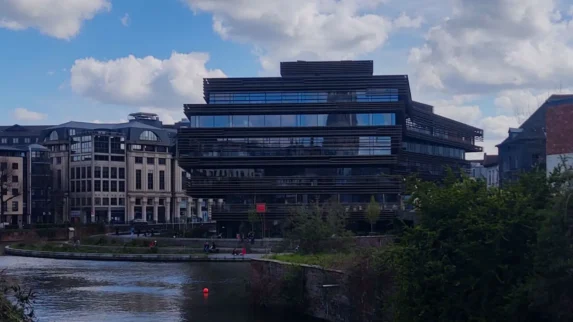
The home of culture
You can see Gent Zuid as the home of culture in the city. Here you find the library De Krook, as well as theatre halls like Capitole, Minardschouwburg, De Vooruit and Wintercircus. Central at Gent Zuid is the large Koning Albertpark located.
Canals and the Leie river cross the whole city of Ghent. So, making a boat trip through the city is a great thing to do. This is the ideal way to see and discover Ghent from the water, which gives you another view on the city. In the mean time, you'll get a lot of interesting information about the many historical buildings you will see and the history of Ghent.
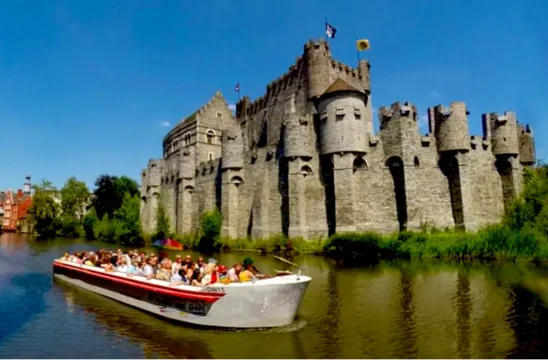
Different shipping companies
You can choose between different shipping companies to make a boat trip through the city. You find them at many places in the city. Some are located at the Graslei and Korenlei, while you find others in the region of the Gravensteen.
Hidden Gems
Like in any city, also Ghent has some hidden gems to discover:
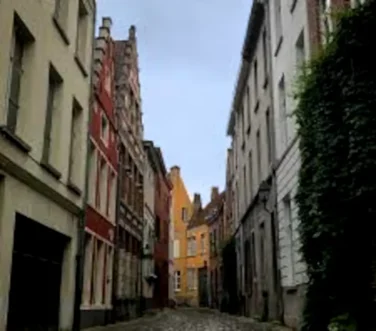
- The Dulle Griet is a cannon in the city, which is used only once. But it also is the name of a bar at the Vrijdagmarkt. This is a bar with more than 500 different beers. But also a special one. When you order a Max beer, then you have to give a shoe as deposit.
- In the region of the city hall, you find a small street with a lot of Graffiti. This is the Graffiti street, now an artistic street and very attractive by photographers and for photo shoots.
- Patershol is known as a neighbourhood of small picturesque streets between the Gravensteen and Oudburg. But, the real Patershol is a small blue gate in a wall. This was the entrance of the monks to enter the monastery from the neighbourhood. As well as for the people who lived in this neighbourhood to get their water from a space inside the walls of the monastery.
- Ganda is the original name of the city of Ghent. Ghent is formed at the confluence of the Leie and the Scheldt. Now it is the place of Portus Ganda, an idyllic marina.
Save the dates
Yearly events to mark in your agenda
What are the famous events? Are there regional festivities? What are the huge city festivals to join every year? Are there festivities you don't may miss in this city? Below, you find some of the famous yearly activities to do in Ghent.
Winter in Ghent
In the winter months, the city centre of Ghent transforms in a wonderful place to cocoon with winter vibes. In December, you have a lot of colours, winter vibes and family fun in the city. While every 3 years, begin February, you can enjoy a huge light festival through the city. The next one is in 2024.
Ghent Marathon
At the end of March, you can participate in a 42 km run through the city. Put on your running shoes and run through 1400 years of history in the city centre of Ghent.
Gentse Feesten
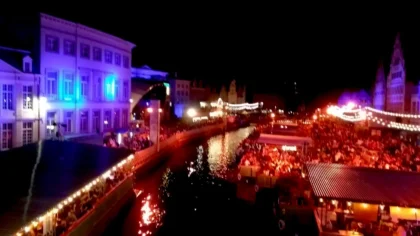
Every year, in the summer, Ghent transforms in a huge city festival. 10 Days of joy, music, spectacles and party that are the Ghent Festivals, Gentse Feesten, at the end of July. Don't miss these wonderful festival in the streets, parks and on the squares everywhere in Ghent. One of the most festive places to be is at Polé Polé. Polé Polé is at the Graslei and Korenlei, where you can enjoy a lot of pop music aside the Leie. Almost every inhabitant of Ghent looks out every year to the Gentse Feesten. It is part of their identity. The Gentse Feesten is a free city festival.
Jazz in't park
Jazz lovers have to be in the Voorhavenpark in Ghent at the begin of September. At Jazz in the park, you can enjoy a lot of modern jazz during 4 days.
Ghent Car-free
Like in a lot of cities in Belgium, also in Ghent there is car-free sunday. This takes always place half of september. So, no motorised vehicles are allowed in the city. This event is part of the week of mobility in Belgium.
Film Fest Ghent
Also Ghent has its own international movie festival. Film Fest Ghent takes place every year in Oktober and is the largest film festival of Belgium. Every year, it attracts around 100 000 visitors. Unique for this festival is that the spotlight is on movie music. SO, they hand out the World Soundtrack Awards.
6 Days of Flanders Cycling
Ghent also is known for his 6 Days of track cycling in Het Kuipke. This cycling event is a must place for joy and pleasure together with sport. Special about this track cycling event is that the velodrome is smaller as the most onces. So, it is shorter and steeper. This also means that the public sits shorter to the track and brings more atmosphere. If you like sport and cycling, this is an absolutely must do event for you.
